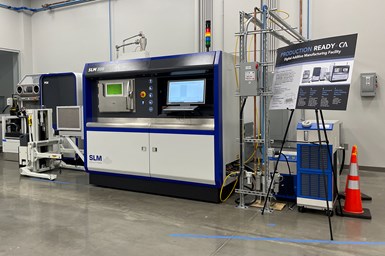Cumberland Additive Acquires Stratasys Direct Manufacturing Metals Operations, Doubles Metal AM Capacity
The agreement also expands and diversifies Cumberland’s material offerings in aluminum, copper and other metal materials.
Cumberland Additive, headquartered in Austin, Texas, chose to locate its LBPF production of lightweight metal parts at Neighborhood 91. This SLM Solutions 500 machine is dedicated to aluminum.
Cumberland Additive has reached an agreement with Stratasys Direct Manufacturing to assume operations of its metal additive manufacturing (AM) operations in Austin, Texas. This acquisition expands and diversifies Cumberland’s material offerings in aluminum, copper and other metal materials.
The agreement will also double Cumberland’s metal AM capacity using laser powder bed fusion (LPBF) technology while maintaining ITAR and AS9100D certifications across operations, which is essential to Cumberland's quality standards.
Cumberland says the acquisition supports its future growth strategy for broadening its material portfolio and services. It adds metal printers and a heat treat furnace to expand capacity. The additional machines will complement current CNC machining capabilities. It will also provide diversification into synergistic markets, thereby broadening its customer reach.
Under the Cumberland banner, the existing Stratasys metals team will remain in place and continue operations at the same location, while all current equipment and IP will remain in place.
“Our leadership team was looking for an opportunity to provide our customers with additional AM metal production capacity and material diversification,” says John Jenkins, Cumberland Additive president. “This convergence with Stratasys Direct Manufacturing made absolute sense for both parties as this enables our operations to double in size, while Stratasys can continue focusing on their core business.”
Cumberland Additive is headquartered in Pflugerville, Texas, offering series production of parts and engineering design services in both metals and polymer materials using LBPF technology to support the aerospace, defense, space and energy markets. With this acquisition, Cumberland now operates out of three locations, including the facility at Neighborhood 91 in Pittsburgh, Pennsylvania.
“This acquisition is a win for both companies as it streamlines operations and strengthens our portfolio for future strategic partnerships,” says Dawne Hickton, Cumberland board chairperson.
Cumberland Additive began as Directed Manufacturing in 2006. The company achieved steady growth throughout multiple markets in aerospace, defense, space, medical, automotive and energy, expanding capabilities from plastic prototyping to serial production of polymers and metals. Under new ownership since May 31, 2019, Cumberland Additive provides engineering services and turnkey production of parts utilizing LBPF.
Related Content
-
Additive Manufacturing Versus Cavitation
The design freedom possible with laser powder bed fusion (LPBF) metal 3D printing is making it faster and easier to produce complex anticavitation devices for valves.
-
DMG MORI: Build Plate “Pucks” Cut Postprocessing Time by 80%
For spinal implants and other small 3D printed parts made through laser powder bed fusion, separate clampable units resting within the build plate provide for easy transfer to a CNC lathe.
-
3D Printed NASA Thrust Chamber Assembly Combines Two Metal Processes: The Cool Parts Show #71
Laser powder bed fusion and directed energy deposition combine for an integrated multimetal rocket propulsion system that will save cost and time for NASA. The Cool Parts Show visits NASA’s Marshall Space Flight Center.
















